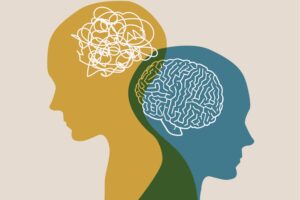Have you ever wondered why some people are more prone to substance use and addiction than others? This complex issue has puzzled healthcare professionals, families, and those struggling with addiction for years. Understanding the key risk factors for addiction can provide critical insights and help prevent or mitigate substance use disorders.
Substance use disorder, often referred to as addiction, is a pervasive issue that affects millions globally. It’s an intricate problem with roots entwined in a person’s environment, biology, and experiences. There’s a significant degree of variability in who becomes addicted and why, and the answer often lies in a combination of risk factors that increase an individual’s vulnerability to addiction.
Let’s dive into the top three addiction risk factors: genetics, environment, and mental health. Additionally, we’ll explore protective factors and interventions that can help reduce these risks and provide a safer, healthier path forward for individuals at risk.
Understanding these components can empower us to take proactive steps in addiction prevention and support those affected by substance use disorders.
What Is Addiction?
Addiction. The word can conjure up stark images — of people we’ve known, scenes we’ve witnessed, or even personal battles we’ve fought. But what does it really mean?
In the broadest sense, addiction, or substance use disorder, refers to the compulsive use of substances despite harmful consequences. It’s a brain disorder characterized by altered structure and functioning, leading to changed behavior, including an increased craving for the substance and continued use despite damaging effects.
But let’s get this straight — addiction doesn’t play favorites. It can affect anyone, irrespective of age, income, education level, or social standing. It’s not a choice nor a moral failing; it’s a chronic disease, much like diabetes or hypertension.
One of the most distressing aspects of addiction is its impact on mental and physical health. Substance use can exacerbate mental health disorders like ADHD and post-traumatic stress disorder or even lead to dual diagnosis, where a person experiences a mental illness and a substance use disorder simultaneously. Physically, the effects range from minor health problems, such as fatigue or diminished immunity, to major issues like heart disease and liver failure.
But addiction’s ripple effects reach far beyond the individual. Family members and loved ones are often caught in the turmoil, suffering emotional pain and, in many cases, bearing the burden of caregiving and financial support. The social cost is equally enormous, from healthcare expenses to lost productivity and crime.
What Is Substance Dependence?
While “addiction” and “substance dependence” are often interchanged, they depict different facets of substance use disorders. Substance dependence, according to the Diagnostic and Statistical Manual of Mental Disorders (DSM-5), is the body’s physical adaptation to persistent substance use, leading to tolerance and withdrawal symptoms upon reduction or cessation of the substance.
Tolerance necessitates higher substance quantities to attain the effect once achieved with less. Conversely, withdrawal symptoms are the physical and mental distress that arises when regular heavy substance use is discontinued.
Yet, addiction delves deeper, straddling physical and psychological dimensions. It involves physical reliance, compulsive behavior, inability to regulate substance use, and continued use despite harmful consequences.
So, while substance dependence may be a component of addiction, it’s not the entirety of it. One can be dependent without addiction — for instance, a patient may be physically reliant on a prescription drug but not misuse it compulsively. Alternatively, an individual could be addicted without dependence, like a cannabis user who compulsively uses but isn’t physically dependent.
Understanding these distinctions aids in recognizing, diagnosing, and treating substance use disorders while dispelling misconceptions about addiction.
The Top 3 Addiction Risk Factors
The factors that contribute to substance use and addiction are numerous and varied. However, research suggests that certain factors tend to hold more weight than others.
Let’s explore the top three risk factors consistently associated with an increased risk of addiction.
Genetics and Family History
It’s true — addiction can run in families. But it’s not as simple as inheriting a “substance abuse” gene. Rather, a complex interplay of genetics and environment comes into play. Researchers estimate that genetics accounts for 40 to 60 percent of a person’s risk of addiction.
Certain genetic factors can predispose an individual to addiction. For instance, genes can influence how one experiences the effects of a drug or how quickly they metabolize it.
Other genes may be linked to impulsivity, a trait often seen in those with substance use disorders. Moreover, a family history of addiction can also imply a shared environment that increases risk.
This could include the availability of substances, lack of parental supervision, or normalization of drug use. It’s essential to remember that a family history of addiction doesn’t guarantee a person will develop an addiction, but it does increase the risk.
Early Exposure and Adolescence
The early bird may catch the worm, but when it comes to drug use, early exposure can be a recipe for disaster. Adolescent brains are still developing, particularly the parts involved in decision-making, risk assessment, and impulse control.
Young people who start using substances at an early age are at a much higher risk of developing addiction. Early drug use can prime the brain for addiction, making young adults more vulnerable to substance use disorders later in life.
Additionally, adolescence is a time when peer pressure and the desire for acceptance are at their peak. The pressure to fit into a peer group can lead adolescents to experiment with drugs, and in some cases, this experimentation can progress to addiction.
Mental Health Disorders
The link between mental health conditions and substance use disorders is well established. Those who struggle with mental health issues, such as anxiety, depression, ADHD, or post-traumatic stress disorder, are at a greater risk of developing substance use disorders — a phenomenon often referred to as “dual diagnosis.”
The reasons for this are twofold. On the one hand, individuals may use substances as a way to self-medicate, attempting to alleviate symptoms of their mental health disorder. On the other hand, substance use can exacerbate mental health conditions, creating a vicious cycle.
Understanding this correlation is crucial because treating only one condition can leave the other untreated and likely lead to a relapse. Therefore, an integrated approach that treats both conditions simultaneously is often the most effective.
Protecting Against Addiction: The Role of Protective Factors
Though risk factors can increase a person’s likelihood of developing an addiction, the presence of protective factors can significantly mitigate these risks. These factors act as a safety net, reducing the impact of risk factors and promoting healthier decisions and behaviors.
Family and Community Support
One of the most potent protective factors against addiction is strong family support. Love, understanding, and communication can help a person navigate the challenges of life without resorting to substance use. Encouraging open dialogues about substance use and addiction can also play a critical role in prevention.
Additionally, community support plays a substantial role in preventing substance abuse. This can come in various forms, such as school-based interventions, community recreational activities, or local support groups. Communities that offer these resources provide healthier outlets and alternatives for individuals, especially young adults and adolescents.
Positive Social Connections and Peer Groups
The company we keep can significantly impact our behaviors and decisions, especially during our formative years. Friends who discourage drug use and partake in positive, healthy activities can act as a strong protective factor against addiction.
Having supportive, positive friendships can provide emotional comfort, reduce feelings of loneliness, and promote better coping mechanisms. In the face of peer pressure, having at least one friend resistant to drug use can make a big difference.
Mental Health Care and Coping Skills
Access to mental healthcare is a crucial protective factor. Regular check-ups with healthcare providers can help identify mental health conditions early and provide the necessary support or intervention. It’s important to remember that mental health conditions can often precede addiction, so managing these conditions can significantly reduce the risk of substance use disorders.
Developing healthy coping skills is another effective protective factor. Stress is a part of life, and how we manage it can impact our susceptibility to addiction. Techniques such as mindfulness, meditation, exercise, and other stress management methods can serve as healthier alternatives to substance use.
Getting Help With Soba
At Soba Recovery, we understand the complexities of addiction and the unique challenges each individual faces. Our compassionate, holistic approach to treatment ensures that you or your loved one receives the necessary care to overcome addiction. Whether you’re struggling with opioids, methamphetamines, alcohol, or other substances, our experienced team is here to help.
Our treatment programs address not just the physical symptoms of addiction but also the underlying mental health conditions and environmental factors that may contribute to substance misuse. We believe in equipping our clients with the tools they need to live fulfilling, substance-free lives.
If you or a loved one is battling addiction, don’t wait. Reach out to Soba Recovery today, and take the first step towards a healthier, brighter future.
Sources:
What Is a Substance Use Disorder? | American Psychiatric Association
Drug addiction (substance use disorder) – Symptoms and causes | Mayo Clinic
Is Addiction Hereditary? | Cleveland Clinic
Stress: Coping with Everyday Problems | Mental Health America
DSM-5 Criteria for Substance Use Disorders | Gateway Foundation





